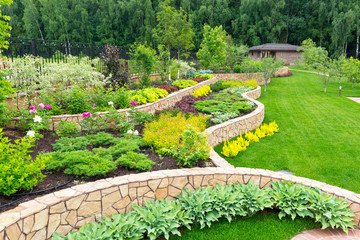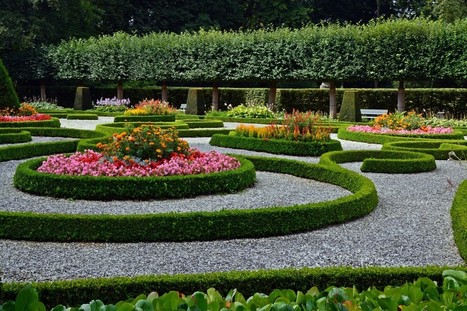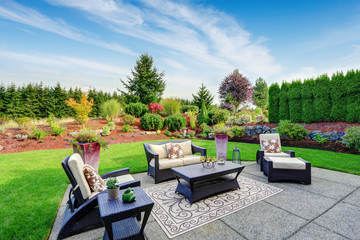Landscaping Ideas For Your Home
Landscaping involves changing the visible features of a piece of property. This can include adding or removing trees, enhancing gardens with grass and shrubs, and using decorative and functional elements.

Border shapes can be geometric (square, rectangle, circle) or naturalistic (irregular edge). Straight lines suit formal designs, while curved borders create more casual looks. Visit https://www.primecutlawnky.com/ to learn more.
August is a great time to plant trees and shrubs. If you choose plants adapted to your climate zone, they’ll establish quickly and better survive the winter.
When choosing plants, consider the mood you want to create and how much maintenance you can handle. For example, if you have young children or pets, look for “bulletproof” plants that can withstand trampling, like ground phlox and low-growing sedum.
Think about the shapes of individual plantings and how they work with the style of your home. If your house is mid-century modern, for instance, rectilinear forms might suit it better than round ones. Finally, remember that empty spaces, or voids, can also be important parts of your landscape design. They help balance the mass of plantings and give your garden a pulled-together look.
Lastly, it’s a good idea to plant your shrubs and trees from the inside out—starting at the house and working outward. This will prevent them from becoming crowded out by larger, established plants and allow you to plan ahead for future maintenance. Incorporate deciduous shrubs and perennials to add interest in the winter months, as well as evergreens for year-round visual interest. You can even use a combination of low-growing plants as edging for your garden beds and paths.
Patios
A patio is a flat, paved outdoor area that adjoins your home and offers an easy transition and extension to your home for relaxing, entertaining and recreation. Patios come in many designs to accommodate homeowners’ lifestyles and preferences, and they can be crafted with different materials including concrete, flagstone, pavers, bricks and gravel.
Patios are ideal for bringing together family members and friends for outdoor entertainment and socializing. They also offer a great place for cooking and eating meals, especially during warmer months when it is not practical to eat indoors. A patio can be equipped with a grill, chairs and tables and a few plants to create a comfortable outdoor living space.
A patio can be surrounded by walls or fences to protect it from weather conditions like heavy rain, strong winds and snow. It can be built from a variety of materials, but the most common are pavers, concrete and wood. Pavers are often preferred because they are inexpensive, easy to maintain and attractive. They can be made of different colors and styles to complement the overall look of the patio and to match the surrounding landscaping.
Patios can be enclosed to allow enjoyment even during rainy or cold weather, but they can also be left open and act as an extension of your house. Patios are one of the most desirable features for any backyard and can add tremendous value to your property when it is time to sell your home.
A patio can help reduce the amount of time and effort spent maintaining a lawn, such as mowing, fertilizing, and raking leaves in the fall. It can also help to prevent water runoff during storms, as well as reduce the potential for mud and soil erosion. In addition, a patio can offer an alternative to the traditional grass lawn for people with allergies. It can be surrounded by fencing and planted with low-maintenance shrubs and perennials like a groundcover of creeping jenny (Lysimachia nummularia ‘Aurea’) and blue fescue (Festuca ‘Elijah Blue’). The combination of these easy landscape ideas provide a colorful backdrop for a seating area that is both comfortable and functional.
Walkways
The design of walkways is as much a formative landscaping element as plantings and can make or break a yard’s overall look. The structure provides a path to other areas of the garden or to the front door and is often the focal point for the yard. The size, shape and material of the walkway should complement the house and be consistent with the style of the landscape.
Wide, paved walkways are often used to create a clear circulation route from one point to another. These are usually located near to or at ground level and may be paved with pavers, concrete, or asphalt.
Walkways can also be designed as raised structures that allow access to difficult to reach or environmentally sensitive areas, such as beaches (these are known as boardwalks) or forest trails. They can also be built as tourist attractions to give visitors a unique experience, such as London’s glass walkway path.
For homeowners, walkways are often constructed using pavers or stone. These are generally available in a range of earth tones that work with many styles of home. The color of the material can also be matched to existing brick or stone elements, or to other materials in the landscape (such as retaining walls) for a cohesive and unified look.
As well as being attractive and functional, the placement of a walkway will determine how much sunlight it receives. Shaded or damp walkways tend to attract mold, mildew and algae which can stain surfaces unless regularly cleaned. It is therefore important to consider the location of a walkway when designing the surrounding plants to ensure that it will receive adequate sunlight.
Structures such as low fences and hedges can help to define garden spaces and add interest throughout the year. They are also ideal for directing the eye to a key feature, such as a seating area or garden display. For example, a curvaceous boxwood hedge can be used to frame a walkway up to a garden shed or a pergola, providing both shade and a way of moving the eye across the yard.
Retaining Walls
Retaining walls are a beautiful and unique way to elevate the landscape on your property. Whether used to create a stunning entrance or simply to add height to a flower bed, the possibilities are limitless. They can also serve an important function, such as preventing soil erosion on a sloped property.
Often constructed of stone, pavers or concrete, these structures can add an element of visual interest to your property. The textured surfaces and unique color tones of these materials are a nice contrast to the softer landscaping elements such as grass, flowers, trees or shrubbery that make up the majority of your yard.
The design of retaining walls is completely up to the property owner and can be tailored to match their vision. They can be made of a variety of different materials such as corten steel, a type of metal that rusts for an industrial look, or they can be rendered for a clean and crisp appearance. They can be painted to match the surrounding foliage or a stark white finish is a popular choice that works well with modern and contemporary style homes.
For a more rustic or natural feel, wood can be used in the construction of retaining walls. This is a budget-friendly option that works with almost any landscape design and blends in seamlessly with the natural environment. However, it is not as strong as other options and a wood retaining wall may need to be maintained more frequently than a retaining wall built from other material types.
Retaining walls can also be constructed from a wide range of other products such as brick, poured concrete and even blocks. They can be capped with a variety of different materials such as stone, brick or tiles to add a personal touch. Some retaining walls are also designed for support purposes to hold outdoor structures such as gazebos, gates and pergolas. They are built to withstand the vertical pressure of these elements and can be made from a variety of different materials including pavers, block, concrete or wood.
Retaining walls are a great addition to any home and can be custom designed for the needs of each property. They can improve the aesthetics of your home, increase the usable space on a sloped property and prevent soil erosion that can damage plants and the foundation of the house.




